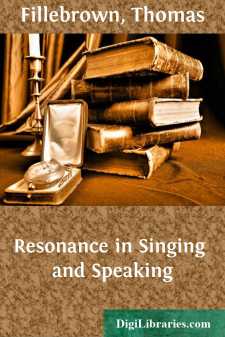Categories
- Antiques & Collectibles 13
- Architecture 36
- Art 48
- Bibles 22
- Biography & Autobiography 813
- Body, Mind & Spirit 142
- Business & Economics 28
- Children's Books 17
- Children's Fiction 14
- Computers 4
- Cooking 94
- Crafts & Hobbies 4
- Drama 346
- Education 46
- Family & Relationships 57
- Fiction 11829
- Games 19
- Gardening 17
- Health & Fitness 34
- History 1377
- House & Home 1
- Humor 147
- Juvenile Fiction 1873
- Juvenile Nonfiction 202
- Language Arts & Disciplines 88
- Law 16
- Literary Collections 686
- Literary Criticism 179
- Mathematics 13
- Medical 41
- Music 40
- Nature 179
- Non-Classifiable 1768
- Performing Arts 7
- Periodicals 1453
- Philosophy 64
- Photography 2
- Poetry 896
- Political Science 203
- Psychology 42
- Reference 154
- Religion 513
- Science 126
- Self-Help 84
- Social Science 81
- Sports & Recreation 34
- Study Aids 3
- Technology & Engineering 59
- Transportation 23
- Travel 463
- True Crime 29
Resonance in Singing and Speaking
Categories:
Description:
Excerpt
INTRODUCTION
When a youth it was my lot to be surrounded by examples of faulty vocalism, such as prevailed in a country town, and to be subjected to the errors then in vogue, having at the same time small opportunity for training in the application of principles, even as then imperfectly taught. At middle life I had given up all attempt at singing and had difficulty in speaking so as to be heard at any considerable distance or for any considerable length of time. Professional obligations to my patients, however, compelled me later to take up the subject of vocal physiology. This I did, guided by the ideas current on the subject.
About 1880 I became satisfied that many of the current ideas were incorrect, and determined to start anew, and to note in detail the action of each organ used in vocalization and articulation. To this end I sought vocal instruction and advice, which, modified by my own observations, have produced the most gratifying results.
Up to that time it had been held that the nasal cavities must be cut off from the mouth by the closing of the soft palate against the back of the throat; that the passage of ever so little of the sound above the palate would give a nasal twang, and that the sound was reinforced and developed only in the cavities of the throat and mouth. My practice in Oral Surgery, coupled with my own vocal studies exposed this fallacy and revealed to me the true value of nasal resonance.
The late Mme. Rudersdorff had begun to recognize the effect of nasal resonance, but she left no published record of her conclusions. It does not appear that she or her contemporaries realized the true value of the nasal and head cavities as reinforcing agents in the production of tone, or appreciated their influence upon its quality and power.
There are perhaps few subjects on which a greater variety of opinion exists than on that of voice culture, and few upon which so many volumes have been written. Few points are uncontested, and exactly opposite statements are made in regard to each.
Formerly great stress was laid upon the distinction between "head tones" and "chest tones," "closed tones" and "open tones." The whole musical world was in bondage to "registers of the voice," and the one great task confronting the singer and vocal teacher was to "blend the registers," a feat still baffling the efforts of many instructors.
Many teachers and singers have now reached what they consider a demonstrated conclusion that registers are not a natural feature of the voice; yet a large contingent still adhere to the doctrine of "register," depending for their justification upon the unreliable evidence furnished by the laryngoscope, not realizing that there will be found in the little lens as many different conditions as the observers have eyes to see. Garcia himself, the inventor of the laryngoscope, soon modified his first claims as to its value in vocal culture.
On this point we have the testimony of his biographer, M.S. McKinley:
"As far as Garcia was concerned, the laryngoscope ceased to be of any special use as soon as his first investigations were concluded. By his examination of the glottis he had the satisfaction of proving that all his theories with regard to the emission of the voice were absolutely correct. Beyond that he did not see that anything further was to be gained except to satisfy the curiosity of those who might be interested in seeing for themselves the forms and changes which the inside of the larynx assumed during singing and speaking."
Of similar purport is the word of the eminent baritone, Sir Charles Santley, who, in his Art of Singing, says:
"Manuel Garcia is held up as the pioneer of scientific teaching of singing. He was—but he taught singing, not surgery! I was a pupil of his in 1858 and a friend of his while he lived; and in all the conversations I had with him I never heard him say a word about larynx or pharynx, glottis or any other organ used in the production and emission of the voice. He was perfectly acquainted with their functions, but he used his knowledge for his own direction, not to parade it before his pupils."
The eminent London surgeon and voice specialist, Dr. Morell Mackenzie, says of the laryngoscope, "It can scarcely be said to have thrown any new light on the mechanism of the voice"; and Dr....


